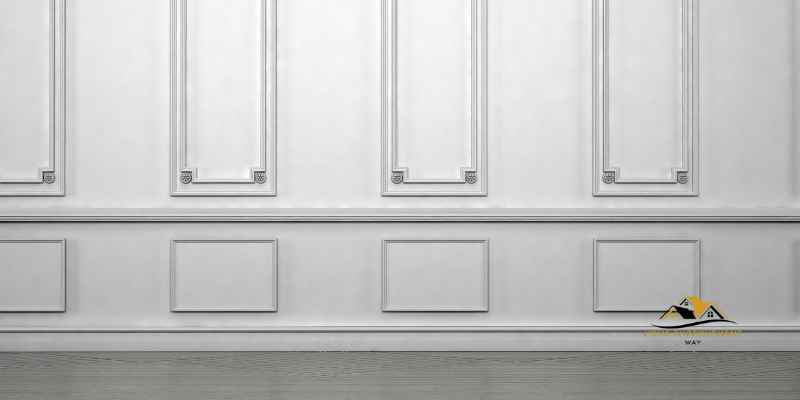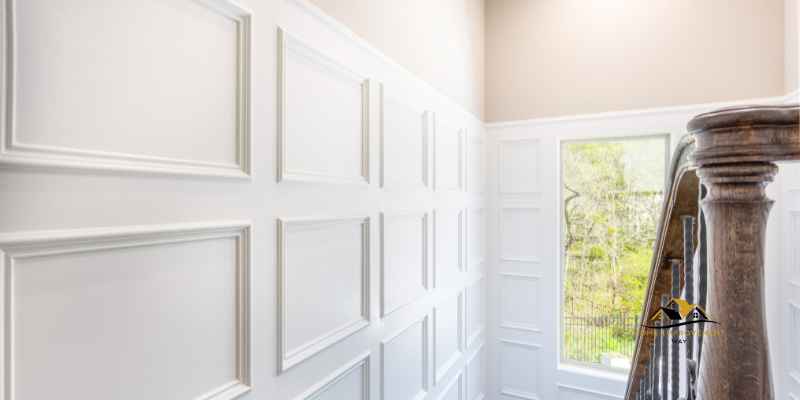To paint wainscoting, choose a semi-gloss paint for spraying and a satin finish for brushing. You can also use a brush or roller to apply the paint.
Proper preparation and tools are essential for a successful wainscoting painting project. Additionally, consider whether to paint the wainscoting and walls the same color to create a cohesive look, especially in rooms with low ceilings. Painting wainscoting requires attention to detail and proper technique.
Whether you’re looking to refresh the existing wainscoting or planning a new installation, knowing the right type of paint and the correct application method is crucial for achieving a professional finish. We will explore the best paint options for wainscoting, the tools needed for the job, and tips for maintaining painted wainscoting. By the end, you’ll have all the information you need to tackle your wainscoting painting project with confidence and achieve stunning results.
Choosing The Right Paint For Wainscoting
When it comes to painting wainscoting, choosing the right paint is crucial for achieving a flawless finish. The type of paint and finish you select can significantly impact the overall look and durability of your wainscoting. Let’s explore some key considerations when choosing the perfect paint for your wainscoting.
Choosing Between Semi-gloss And Satin Finish
When it comes to wainscoting, the choice between semi-gloss and satin finish can make a notable difference in the final appearance. Semi-gloss paint offers a shiny, reflective finish that is highly durable and easy to clean. It is a great option for wainscoting that will be subjected to high traffic areas or potential moisture exposure. On the other hand, satin finish paint provides a smooth, velvety appearance with a subtle sheen. It is ideal for wainscoting in areas where you want to minimize the appearance of imperfections. Consider the location and purpose of your wainscoting to determine whether a semi-gloss or satin finish is more suitable for your project.
Spraying Vs. Brushing Paint On Wainscoting
When painting wainscoting, the application method, whether spraying or brushing, can influence the final result. Spraying paint on wainscoting can create a smooth, even finish with minimal brush marks. It is an efficient method for covering large areas and intricate details. Alternatively, brushing paint allows for greater control over the application and is well-suited for reaching tight corners and edges. Consider the size and intricacy of your wainscoting, as well as your proficiency with each method, to determine whether spraying or brushing is the best approach for your project.
Preparing Wainscoting For Painting
Before painting your wainscoting, it is crucial to properly prepare the surfaces to ensure a smooth and long-lasting finish. Follow these steps to prepare your wainscoting for painting:
Cleaning And Sanding Wainscoting Surfaces
- Start by cleaning the wainscoting surfaces with a mild detergent and water solution to remove any dirt, dust, or grease.
- Use a damp cloth to wipe down the surfaces and ensure they are completely clean and free of any residue.
- Allow the wainscoting to dry thoroughly before proceeding to the next step.
- Next, lightly sand the wainscoting surfaces with fine-grit sandpaper to smooth out any imperfections and create a better surface for paint adhesion.
- Wipe away any sanding dust with a tack cloth to ensure a clean surface for painting.
Using Primer On Wainscoting
- Apply a high-quality primer to the wainscoting surfaces to help the paint adhere better and provide a uniform base for the paint color.
- Use a brush or roller to apply the primer evenly, covering all areas of the wainscoting.
- Allow the primer to dry completely according to the manufacturer’s instructions before proceeding with the paint application.
Painting Techniques For Wainscoting
To paint wainscoting, choose between Semi-Gloss for spray painting or Satin Finish for brushing. Prep the panels well to avoid imperfections. Consider white or bold colors for a standout look. It’s easier to tape off the trim before painting the walls.
Regular dusting and mild detergent cleaning maintain the finish.
Brushwork Tips For Wainscoting
When painting wainscoting, use high-quality brushes to ensure smooth and even coverage. Start from the top and work your way down in long, even strokes. Avoid overloading the brush to prevent drips and uneven application.
Rolling Paint Evenly On Wainscoting
For rolling paint, choose a small roller to navigate the intricate details of wainscoting. Apply paint in a crisscross pattern to ensure even distribution. Work in small sections to maintain consistency.
Step-by-step Guide To Painting Wainscoting
Painting wainscoting can instantly elevate the look of any room, adding a touch of elegance and charm. With the right tools and techniques, you can achieve a professional finish that enhances the overall aesthetic of your space. Follow this step-by-step guide to painting wainscoting and transform your interiors with a fresh, polished look.
Step 1: Preparing The Workspace
Before diving into the painting process, it’s crucial to prepare the workspace to ensure a smooth and efficient application. Here are the essential steps to prepare the wainscoting:
- Clean the surface thoroughly to remove any dust, dirt, or grease.
- Protect the surrounding areas with painter’s tape and drop cloths to prevent accidental spills and splatters.
- Fill any visible nail holes or imperfections with wood filler and sand the wainscoting for a smooth finish.
Step 2: Applying The First Coat Of Paint
Once the preparation is complete, it’s time to apply the first coat of paint to the wainscoting. Follow these steps for a flawless application:
- Begin by using a high-quality paintbrush to cut in around the edges and corners of the wainscoting.
- Next, use a roller to apply an even coat of paint to the larger flat surfaces, working in small sections to ensure thorough coverage.
- Allow the first coat to dry completely before proceeding to the next step.
Step 3: Adding A Second Coat For Coverage
To achieve a professional-looking finish, applying a second coat of paint is essential. Follow these steps to ensure thorough coverage and a uniform appearance:
- Repeat the cutting-in and rolling process with the second coat of paint, paying attention to any areas that may require additional coverage.
- Inspect the wainscoting carefully to ensure that the second coat provides a smooth and consistent finish.
Step 4: Finishing Touches And Cleanup
With the painting process complete, it’s time to add the finishing touches and tidy up the workspace. Here’s what you need to do:
- Remove the painter’s tape and drop cloths carefully, ensuring that no paint smudges onto the surrounding areas.
- Inspect the wainscoting for any touch-ups or imperfections, addressing them with a small brush or roller if necessary.
- Clean your painting tools and dispose of any leftover materials responsibly.
Maintaining Painted Wainscoting

Dusting and cleaning your painted wainscoting regularly is essential to keep it looking fresh and vibrant.
- Use a soft cloth or duster to gently remove dust and dirt from the surface.
- For deeper cleaning, dampen a cloth with water and wipe down the wainscoting.
Using Mild Detergent For Stubborn Stains
When faced with stubborn stains on your painted wainscoting, using a mild detergent can help remove them effectively.
- Mix a small amount of mild detergent with water to create a gentle cleaning solution.
- Apply the solution to the stained areas using a soft cloth or sponge.
- Gently scrub the stains until they are lifted, then rinse the area with clean water.
Creative Ideas For Painted Wainscoting
Enhance your interior with painted wainscoting by exploring creative ideas like two-toned colors, geometric patterns, or a distressed finish. Experiment with different paint finishes and colors to add depth and character to your wainscoting, creating a unique and personalized look for your space.
Wainscoting is a classic wall treatment that adds elegance and sophistication to any room. It’s a versatile design element that can be painted in a variety of colors to match your decor and personal style. If you’re looking for creative ideas for painted wainscoting, you’ve come to the right place! In this post, we’ll explore some exciting ways to transform your wainscoting with paint.
Matching Wainscoting Color to Walls
One of the most popular ways to paint wainscoting is to match the color to the walls. This creates a seamless look that makes the room feel larger and more cohesive. If you have a bold wall color, consider painting the wainscoting in a lighter shade of the same color. This will create a subtle contrast that adds depth to the room. If you have a neutral wall color, you can use wainscoting to add a pop of color. Consider painting the wainscoting in a bold hue that complements your decor.
Exploring Two-Tone Wainscoting Designs
Another creative idea for painted wainscoting is to use two-tone designs. This is a great way to add visual interest to the room and create a unique look. One popular two-tone design is to paint the wainscoting in a darker shade than the walls. This creates a dramatic contrast that draws the eye. You can also use two different colors for the upper and lower portions of the wainscoting. This creates a playful look that adds personality to the room.
If you’re feeling adventurous, you can even use stencils to create intricate designs on the wainscoting. This is a great way to add texture and dimension to the room. You can use a contrasting color for the stencil design or stick to a monochromatic color scheme for a subtle effect.
In conclusion, there are many creative ideas for painted wainscoting that can transform your room into a work of art. Whether you choose to match the wainscoting color to the walls or explore two-tone designs, the possibilities are endless. With a little creativity and some paint, you can create a stunning look that will impress your guests and make you feel at home.
Common Questions About Painting Wainscoting
When it comes to painting wainscoting, there are often common questions that arise. Addressing these questions can help ensure a successful and visually appealing paint job. Let’s explore some of the most frequently asked questions about painting wainscoting.
Should Wainscoting Be Painted White?
Painting wainscoting white is a classic and popular choice, but it’s not the only option. Boldly painted wainscoting in colors like green, blue, or even a dramatic purple can create a standout focal point in your home. Ultimately, the decision to paint wainscoting white or in a different color depends on your personal style and the overall aesthetic you want to achieve.
Order Of Painting: Walls Or Wainscoting First?
When it comes to the order of painting, whether to start with the walls or the wainscoting first can be a matter of personal preference. However, it’s generally recommended to paint the trim first, as it’s easier to tape off the trim than the walls. Additionally, taping the trim is more likely to result in clean, crisp lines, especially if the walls are uneven.
Expert Recommendations And Tips

Choosing The Right Sheen For Wainscoting
When it comes to painting wainscoting, the sheen of the paint plays a crucial role. For a flawless finish, opt for a Semi-Gloss sheen if you are spray painting the panels. If you are using a brush, a Satin Finish is recommended. Remember, Semi-Gloss may highlight imperfections, while Satin provides a more forgiving look.
Best Practices For Using Benjamin Moore Advance Paint
- Prep the wainscoting and gather the necessary tools for painting.
- Consider whether to paint the wainscoting white or opt for a bolder color.
- When painting, determine whether to use a brush or a roller based on the desired finish.
- For a professional touch, follow step-by-step guides from experts like Benjamin Moore or Maison de Pax.
- Maintain the painted wainscoting by dusting regularly and using mild detergent when necessary.
Frequently Asked Questions
What Kind Of Paint Do You Use On Wainscoting?
For wainscoting, use Semi-Gloss paint if spraying panels or Satin Finish if brushing. Semi-Gloss shows imperfections, while Satin is forgiving.
Do You Paint Wainscoting With A Brush Or Roller?
For painting wainscoting, you can use both a brush and a roller. The brush is used for detailed work and the roller is used for a smooth finish. Choose the tool that suits your painting style and the specific requirements of your wainscoting.
Should Wainscoting Be Painted White?
While most wainscoting is painted white or off-white, it is not necessary to do so. You can choose bolder colors such as green, blue or purple to create a statement. The type of finish to use depends on whether you are brushing or spraying the panels.
A satin finish is recommended for brushing, while semi-gloss is best for spraying. It is a matter of personal preference whether to paint the walls or the wainscoting first.
Should You Paint The Wall Or Wainscoting First?
For best results, paint the wainscoting first before painting the walls to achieve a clean and seamless finish.
Conclusion
In painting wainscoting, choose the right paint finish based on your method for a flawless look. Experiment with bold colors for a unique touch. Consider personal preference when deciding whether to paint walls or trim first. Proper maintenance is key to preserving the beauty of painted wainscoting.


